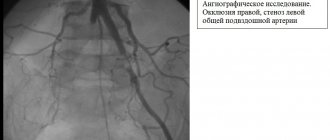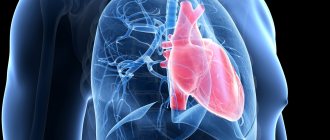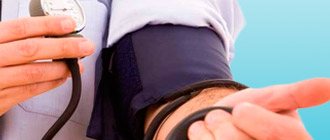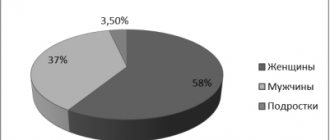High blood pressure or arterial hypertension is considered the most common reason for visiting a cardiologist. According to WHO, it affects 20 to 30% of the world's adult population. With age, the situation only gets worse - more than half of older people over 65 years of age have this disease, and its hemorrhagic complications (stroke, heart attack) often become fatal for a person.
Let's consider the norm and pathological changes, including those that threaten the transition to a hypertensive crisis. Let's touch on the causes, signs and methods of correcting high blood pressure?
What is high blood pressure?
High blood pressure (BP) is said to occur when its systolic and diastolic components rise above the physiological threshold.
Normal blood pressure according to WHO:
- systolic (upper) – 120-129 mm Hg. st;
- diastolic (lower) – 80-84 mm Hg. Art.
If, when measuring blood pressure, the upper number is 140 or higher, and the lower number is 90 or higher, then this pressure is considered elevated. It should be understood that systematically recorded high blood pressure is considered a pathology. Episodes of its increase in the morning, during intense physical activity, fear, and stress are natural for the body.
According to medical observations, the following blood pressure levels are considered very dangerous - for the upper 180, for the lower 120. In this case, there is a high probability of developing a hypertensive crisis.
Causes of high blood pressure
Physiological factors
A short-term increase in blood pressure is observed when the sympathoadrenal system is activated.
This happens under stress and severe fear. Blood pressure increases moderately and is not accompanied by a serious deterioration in health. After eliminating the traumatic factor, the condition returns to normal. During fever, the tonometer readings also change, their increase is proportional to the level of body temperature. A widespread phenomenon is “white coat syndrome.” When measuring blood pressure in a medical facility (for example, during a medical examination), its level exceeds the norm. This is explained by the excitement and nervousness that the patient experiences when seeing medical workers. At the same time, self-monitoring of pressure at home does not show deviations from the norm. It is believed that the presence of such a syndrome increases the risk of developing hypertension in the future.
Arterial hypertension
Primary arterial hypertension is the most common pathological cause of high blood pressure. Problems with blood pressure mainly begin after 50 years of age. When measured with a tonometer, values above 140/90 mm Hg are obtained. Art. Registration of proportionally increased systolic and diastolic pressure is typical. The diagnosis of arterial hypertension is established if the indicated values were obtained from 3 independent measurements.
Cardiovascular diseases
An increase in systolic pressure is a typical manifestation of atherosclerosis. For coarctation of the aorta, the presence of elevated blood pressure in both arms is more specific; when measuring values in the legs, normal values are obtained. Upon visual examination, there is noticeable good development of the muscles of the arms and torso with relatively short and weak lower limbs.
Blood pressure increases with Takayasu's disease (nonspecific aortoarteritis). A pathognomonic sign is that increased blood pressure is recorded on the arm and leg of one half of the body, while on the other side the level remains normal. Symptoms appear in young patients, most often between 15 and 30 years. Hypertension is observed with stenosis of the carotid and vertebrobasilar arteries, aortic valve insufficiency, and complete atrioventricular block.
Kidney diseases
The presence of a symptom in case of kidney damage is associated with an increased release of vasoconstrictor factors into the blood, retention of water and salts in the tissues. Renal forms of hypertension are characterized by the presence of sharply increased diastolic pressure (up to 110 mm Hg and higher) with a relatively small increase in systolic pressure. A similar clinical picture often occurs in young and middle-aged patients. Several groups of diseases contribute to the appearance of high blood pressure:
- Diseases of the renal parenchyma
: chronic glomerulonephritis and pyelonephritis, diabetic glomerulosclerosis, amyloidosis. - Renal vascular damage
: atherosclerotic stenosis of the renal artery, fibromuscular dysplasia. - Congenital anomalies
: polycystic disease, hypoplasia, horseshoe kidney.
Endocrine disorders
Periodic sharp fluctuations in blood pressure occur in women with complicated menopause. The symptom is accompanied by intense redness of the skin and sweating. It is caused by hormonal changes in the body, disorders of the autonomic innervation of vascular tone. Hormones play a big role in regulating blood pressure, so its increase is provoked by the following endocrine diseases:
- Thyrotoxicosis.
With thyroid pathology, isolated systolic hypertension is recorded, and diastolic blood pressure is normal or even reduced. Tachycardia, finger tremor, hot and dry skin are observed. The pathognomonic symptom is exophthalmos. - Pheochromocytoma.
A tumor of the adrenal medulla is manifested by an increase in pressure to extremely high numbers - from 180/120 mm Hg. Art. Symptoms are usually detected in patients aged 20-40 years. Pheochromocytoma is associated with tachycardia, tachypnea, and severe headache. - Itsenko-Cushing's disease.
There is a persistent increase in pressure that is refractory to drug therapy. Systolic and diastolic pressure increases evenly. A typical combination of high blood pressure with obesity in the upper half of the body, purple stretch marks, and increased hair growth. - Hyperaldosteronism.
It is characterized by a stable and steady increase in blood pressure, which is not relieved by standard medications, in addition to potassium-sparing diuretics. In addition to elevated blood pressure, muscle weakness, functional paresis, and paresthesia are detected.
Preeclampsia in pregnant women
Preeclampsia, which occurs in the second half of pregnancy, is accompanied by an increase in blood pressure over 140/90. Along with hypertension, severe swelling, headaches, and nausea are observed. In the absence of treatment, blood pressure rises to very high levels, visual disturbances and vomiting are added to the symptoms. If convulsions develop against the background of high blood pressure and nephropathy, the condition is said to be transitioning to the stage of eclampsia.
Complications of pharmacotherapy
Fluctuations in blood pressure are one of the most common side effects of drug treatment. Your blood pressure usually changes some time after you start taking the medicine. Exceptions are drugs with sympathomimetic activity, which provoke a sharp jump in blood pressure immediately after use. Complications in the form of high blood pressure are possible when taking the following groups of medications:
- Hormones
: glucocorticoids, oral contraceptives. - Drugs affecting the central nervous system
: MAO inhibitors, tricyclic antidepressants. - Non-steroidal anti-inflammatory drugs
(with long-term use). - Sympathomimetics
: ephedrine, tyramine.
Rare causes
- Pathologies of the central nervous system
: brain tumors and cysts, subarachnoid hemorrhage, meningitis and meningoencephalitis. - Diseases of the blood system
: erythremia, hypercoagulation. - Acute stress
: burn disease, crisis in sickle cell anemia, withdrawal syndrome in alcoholism. - Exogenous intoxications
: lead, thalium, cadmium.
Causes of high blood pressure
Doctors most often record an increase in blood pressure in people with a hereditary predisposition and/or diseases of other organs and systems (pheochromocytoma, hyperthyroidism, atherosclerosis, diabetes, etc.), leading to the development of hypertension as a symptom.
The mechanism of blood pressure increase is realized in two ways:
- neurogenic – vasoconstriction through the response of the sympathetic nervous system;
- humoral – release of vasopressors (catecholamines, renin-angiotensin, etc.) into the blood.
Also important is the disruption of the depressor system, which is responsible for vasodilation.
At the same time, a number of factors that trigger the process of hemodynamic disturbances have long been identified:
- excess weight;
- little daily activity;
- poor nutrition, including preference for fast food, snacking on carbohydrate foods;
- chronic intoxication caused by smoking, alcohol abuse, drug addiction;
- mental and physical stress;
- lack of sleep;
- hormonal changes during puberty, pregnancy, menopause;
- abuse of salt in the diet;
- elderly age;
- harmful working conditions;
- taking medications that can indirectly affect blood pressure (for example, hormonal contraceptives , appetite suppressants, etc.)
With high blood pressure, it is important to monitor the reduction of the influence of these factors in everyday life, which will help reduce the risk of developing the most threatening complications - stroke and heart attack.
Arterial hypertension in adolescents and young adults
For a long time, many researchers in the field of cardiology, as well as medical practitioners, were interested in the problem of hypertension and arterial hypertension in general in older and elderly patients, while arterial hypertension in young and middle-aged people, as well as adolescents, remained unsolved . It should be noted that this problem still persists to a certain extent.
Most doctors have a persistent stereotype regarding the tactics of managing such patients, almost exclusively prescribing a certain group of beta-blocking drugs (atenolol, obzidan, anaprilin).
At the same time, studies have appeared that draw attention to new approaches to the treatment of hypertension at a young age and in adolescents, which have significantly more effective results. Similar approaches are practiced in our clinic.
It should be noted that in practical medicine there has been a clear underestimation of the importance of increased blood pressure in young people and adolescents, as well as middle age, due to the existing risk of developing cardiovascular complications (myocardial infarction, cerebrovascular accident, sudden death, etc. ). At the same time, according to the literature, when assessing the incidence of cardiovascular complications over 5 years after the onset of systolic-diastolic arterial hypertension, it was shown that their frequency was significantly higher in the group of people in whom an increase in blood pressure was first detected at the age of 40-49 years, compared with individuals whose elevated blood pressure was detected at the age of 60-65 years.
Thus, we can say with confidence that the relative risk of developing cardiovascular complications due to increased blood pressure is much higher in young people, and the absolute risk in old age. That is, we can conclude that as we age, “age catches up with arterial hypertension as a risk factor for cardiovascular pathology.”
From all of the above, it follows that in order to quickly reduce the individual risk of cardiovascular complications at a young age, it is necessary to prescribe the most effective antihypertensive drugs from the moment of first treatment.
And in this case, the conversation should actually be about the pathogenetic direction of drug and palliative therapy, that is, about therapy aimed at the direct factors of the onset of the disease.
“SM-Clinic” has the ability to identify various forms of arterial hypertension in young and middle-aged people, as well as in adolescents. The arsenal of diagnostic tools includes a powerful laboratory base, functional diagnostic methods, and clinical and instrumental studies.
Symptoms and signs of high blood pressure
Many people know that hypertension is often asymptomatic, but this is noted only at the beginning. Constantly high blood pressure over time results in a number of clinical symptoms:
- The first signs: rare headaches, dizziness, fatigue, weakness, nervousness, sleep disturbance;
- As it progresses: headaches in the occipital region, “tingling” in the heart area, the appearance of shortness of breath during light physical activity (walking, for example), a feeling of heartbeat, “spots” before the eyes, visual impairment.
External signs of hypertension in men and women are no different. The difference in symptoms mainly depends on the level of pressure and the rate of its increase. Often a sharp increase in blood pressure threatens the development of a hypertensive crisis and rupture of the vessel wall.
If there is no tonometer, what signs indicate high blood pressure?
Blood pressure may rise or fall during the day, returning to normal values. This is how our body reacts to various life circumstances: stress, anxiety, sports or relaxation. However, there are situations when the pressure rises sharply.
How can you tell if it has jumped if you don’t have a tonometer at hand? Is it just a headache that speaks to this?
Characteristic signs of high blood pressure
Let us immediately note that all of the following signs can be both a symptom of high blood pressure and other diseases. If you have encountered them more than once, they grow stronger and do not go away, you should definitely consult a doctor!
Headache
You can often hear that the main sign of high blood pressure is a sharp headache, usually in the back of the head (sometimes in the temples). However, it may not always occur. Hypertension is not just called the “silent killer.” The disease is asymptomatic for a very long time, which means that a person, without knowing it (unless, of course, he uses a tonometer from time to time), walks with high blood pressure. As a result, the body gradually adapts, and even consistently high values do not cause discomfort, including headaches.
- A person reacts with headaches only to changes in pressure, both in the case of a strong increase or decrease,
- If a person has consistently high values, for example, 160/100 mmHg. pillar, he doesn’t feel them. However, with an even greater increase in indicators and even with a decrease to standard values of 120/80 mm Hg. the person will feel bad.
Headache may also be a symptom of low blood pressure.
Memory impairment
High blood pressure affects memory and mental performance. Such people quickly get tired and tired. Due to high pressure, the small arteries of the brain suffer, and the blood supply to the brain is worse. This, in turn, alters normal brain function, leading to memory loss and other problems (such as stroke).
Deterioration of vision and the appearance of “floaters” before the eyes
With a sharp jump in blood pressure, vision can decrease and so-called black spots appear in the eyes. Many people attribute these symptoms to age-related changes or manifestations of other diseases.
When the pressure rises sharply, vascular spasm occurs, in which certain areas of the eye experience a lack of oxygen, which leads to the appearance of flickering “floaters”. When the indicators normalize, these symptoms disappear.
Increased heart rate
The heart rate changes (sometimes people describe the sensation as “heart pounding” or “heart pounding”). A rapid pulse, which can be easily felt when pressed lightly, indicates increased blood pressure.
Excessive sweating
If you do not suffer from hyperhidrosis, severe sweating may indicate a sudden increase in blood pressure. It is often accompanied by symptoms such as numbness of the hands, face, tongue, rapid pulse, shortness of breath, and pain in the heart. As a rule, when the pressure decreases to normal values, increased sweating goes away.
In addition, symptoms may appear associated with the reaction of the human vegetative-vascular system to a sharp rise in pressure:
- redness/pallor of the skin;
- frequent urination (every 5 minutes);
- acute diarrhea;
- feeling of temperature;
- nausea;
- hand trembling;
- wet and cold hands;
- noise in ears.
What to do if you don’t have a tonometer
Of course, only a tonometer can show exact values. However, in emergency cases, you can use the following method. You need to take a comfortable position, lean your back on the back of the chair, and relax. Then feel the pulse on your wrist and count the number of beats in 30 seconds. The result obtained must be multiplied by two. If the heart rate is less than or equal to 60, blood pressure is low, 60-80 beats per minute is normal, more than 80 is increased. In addition, if during the measurement you feel that the pulse is well felt, its rhythm is quite rapid, most likely your blood pressure is increased. The heart rate cannot be heard well, it is interrupted - it is below normal.
IMPORTANT! Without accurately measuring blood pressure with a tonometer, you should not take any medications or antihypertensive drugs.
Cardiologist V.M. Kravtsov
High lower pressure: causes, symptoms
By lower or diastolic pressure we mean the force with which the blood flow acts on the vessels during the diastole (relaxation) phase of the heart. Its value depends on the degree of vascular resistance, an increase in which is observed in the following pathological conditions:
- atherosclerosis - the elasticity of the walls of blood vessels decreases, their lumen decreases, which increases tone and resistance to blood flow;
- kidney pathology leads to vasoconstriction due to the implementation of the renin-angiotensin-aldosterone reaction;
- anatomical and functional changes in the myocardium (dilation of the heart chambers, arrhythmia);
- thyrotoxicosis – a high concentration of thyroid hormones in the blood causes vasospasm;
- diabetes mellitus – vascular patency is impaired;
- tumor of the pituitary gland and adrenal glands - the release of catecholamines into the blood, which constrict blood vessels;
According to statistics, the elderly population and men of any age often suffer from high blood pressure. Signs of its increase are sharp pain in the head, dizziness, tinnitus, and attacks of shortness of breath. Painful discomfort in the cardiac region is possible. Long-term high diastolic pressure threatens the development of a heart attack or stroke.
Increased upper pressure: causes, symptoms
Upper (systolic) pressure reflects the contractile activity of the myocardium during systole. Its increase may be due to various reasons:
- congenital defects and acquired cardiac pathology - coarctation of the aorta, PDA, blockade of the atrioventricular node, insufficiency of the valves at the entrance to the aorta;
- ion deviations - accumulation of sodium and calcium in the blood;
- atherosclerosis of large and small vessels;
- renal pathologies of an inflammatory, autoimmune nature;
- diabetes;
- dehydration of the body.
Over time, increased upper pressure first leads to hypertrophy, and then to wear and tear of the myocardium and the formation of heart failure. The aortic wall becomes rigid due to constant trauma by increasing blood pressure. Hemodynamic disturbances of internal organs are also noted due to inadequate distribution of blood through the vessels.
This type of hypertension is more often recorded in women. It manifests itself as regular headaches, discomfort in the heart, fatigue, memory impairment, tinnitus, and decreased vision.
Treatment of high blood pressure
The main goal of therapy for high blood pressure is to reduce its levels to normal and the maximum possible correction of risk factors (fighting smoking, alcoholism, losing excess weight, doing morning exercises), as well as slowing down the damage to other organs.
Taking into account anamnestic and objective data, various medications are prescribed for hypertension; their main groups are presented below:
- antihypertensive medications to lower blood pressure;
- disaggregants that reduce the risk of hemorrhagic complications;
- statins for correction of lipid metabolism;
- diuretics that indirectly reduce blood pressure;
- according to strict indications, a and/or β-blockers to correct myocardial contractility.
If high blood pressure is a sign of pathology in another organ, then treatment of the underlying disease will be key.
An important aspect in the treatment of high blood pressure is a balanced diet, in which you need to limit salt intake, eat more vegetables, nuts, fruits, healthy vegetable oils (olive, pumpkin). If possible, replace red meat with fish. Reduce the amount of calcium-rich dairy products in your diet.
What to eat for hypertension in men?
03.11.2021
For arterial hypertension , of course, drug treatment is very important if it is prescribed by the attending physician , but do not forget about proper nutrition for this disease. Proper nutrition and diet helps regulate blood pressure.
Basic nutrition rules
- When following a diet for hypertensive patients, you should remember that it is necessary to satisfy the body's energy needs: food and drinks must contain all the necessary nutrients.
- Eat little, but often: regular and small meals several times a day (this is also useful for people who do not suffer from this disease).
- Eat properly processed foods (steamed, grilled, boiled and baked).
- Do not drink strong alcohol.
Following these rules will help stabilize your blood pressure.
How to eat for hypertension in men?
Salt must be limited in the diet. This also applies to animal fats. Food must be prepared without salt. With the approval of a doctor , salt intake is allowed in amounts up to 5 grams per day. When cooking, you can use herbs and spices without salt to improve the taste. The total amount of liquid, including first courses, should not exceed 1.5 liters per day.
If you have arterial hypertension and obesity , you should reduce the calorie content of your diet: remove bread, sugar, cereals, pasta, and potatoes. In consultation with your doctor , arrange fasting days (cottage cheese, kefir, apples, dried fruits).
List of foods that help lower blood pressure:
- berries (especially blueberries);
- beet;
- skim milk and yogurt;
- bananas;
- garlic and herbs;
- black chocolate;
- pistachios (not salted).
Sample menu for the day
Breakfast
- Boiled meat – 50 g
- Vinaigrette (with vegetable oil) – 200 g
- Tea (can be with milk) – 200 ml
Lunch
- Fresh cabbage and apple salad (with vegetable oil) – 150 g
Dinner
- Cabbage soup without meat with sour cream – 250 g
- Boiled meat - 50 g, boiled rice - 100 g
- Apple or orange juice – 200 ml
Afternoon snack
- Tea with milk or apple juice – 200 ml
- Fresh fruits and berries – 150 g
Dinner
- Baked fish – 90 g
- Rice (pilaf) with vegetables – 200 g
- Tea (can be with milk) – 200 g
For the night
- Low-fat (or low-fat) kefir – 200 ml
All day
- Rye and white bread – 100 g each
- Sugar – 30 g
- Butter – 10 g
- Vegetable oil - 20 g
It is worth remembering that you need to adhere to the diet on an ongoing basis. This allows you to delay or avoid switching to drug treatment. Also a prerequisite is the abandonment of bad habits and daily physical activity (simple exercises, walks in the fresh air, swimming, with the permission of a doctor - jogging on a machine or on the street).
As practice shows, following a diet for hypertension helps reduce blood pressure. The diet is well tolerated by patients of any age. It is recommended to make a list of meals for the week at the beginning of the month and keep it simultaneously with your blood pressure diary.
Published in Cardiology, Nutrition and diets Premium Clinic
Prevention
The coherence of the heart and blood vessels is a key link in the health of the whole organism. Thanks to preventive measures, it is possible to maintain their harmony, thereby preventing the development of hypertension. These include:
- a measured lifestyle with adequate physical activity;
- weight loss to normal levels;
- balanced diet;
- quitting smoking, alcohol, drugs.
If the symptoms described above appear, you should begin to systematically measure blood pressure using a tonometer. Regardless of the reasons for high blood pressure, its long-term retention at high levels is a reason to contact a therapist or cardiologist.
Treatment
Help before diagnosis
Normalization of elevated blood pressure levels begins with non-drug measures. To reduce the load on the heart, you need to limit the amount of table salt and liquid in your diet. In case of lipid metabolism disorders, exclude animal fats. It is necessary to establish a daily routine: allocate sufficient time for sleep, add feasible physical activity. Drinking alcohol and smoking are completely excluded.
Conservative therapy
Drug treatment is carried out taking into account the etiology of high blood pressure. For symptomatic conditions caused by stress, it is advisable to prescribe sedatives. Thyreostatics are effective in eliminating hypertension in thyrotoxicosis. Most cases of high blood pressure require the use of classical antihypertensive drugs, which in cardiology are divided into 5 groups:
- Diuretics
. Mainly recommended for elderly patients with concomitant heart failure and edema. The products are not used during pregnancy, hypercalcemia, or gout. - ACE inhibitors
. Indicated for high blood pressure in combination with left ventricular dysfunction, diabetes mellitus, and kidney disease. Not prescribed for pregnant women. - II
receptor blockers . According to the mechanism of action, ARBs are similar to the previous group of drugs, but cause fewer undesirable effects. The disadvantage is the high price. - Calcium antagonists
. They have a vasodilating effect, so they are often used when there is a sharp increase in diastolic blood pressure. An additional effect of the drugs is an antiarrhythmic effect. - Beta blockers
. Can be recommended for young patients as monotherapy. Also taken for concomitant chronic heart failure and tachyarrhythmias.
Surgery
Surgical treatment is mainly used for secreting tumors of the endocrine system, which are therapeutically refractory to elevated blood pressure. Surgical removal of pheochromocytoma, adrenal adenoma, and subtotal resection of the thyroid gland are indicated. For renal causes of hypertension, reconstructive surgery is performed on the renal arteries; in advanced situations, nephrectomy is performed.
Cardiac and vascular surgeons treat some cardiovascular causes of high blood pressure. With coarctation of the aorta, the defect is corrected, after which the symptoms disappear. Patients with aortic insufficiency require heart valve replacement. For complete AV block causing hypertension, a permanent pacemaker is implanted.








